

CarExpert.com.au
The CarExpert team's favourite cars of 2025
4 Hours Ago
With an all-new model on the way, how does the current Audi RS3 Sedan fare on track against its Mercedes-AMG A45 S arch-nemesis?

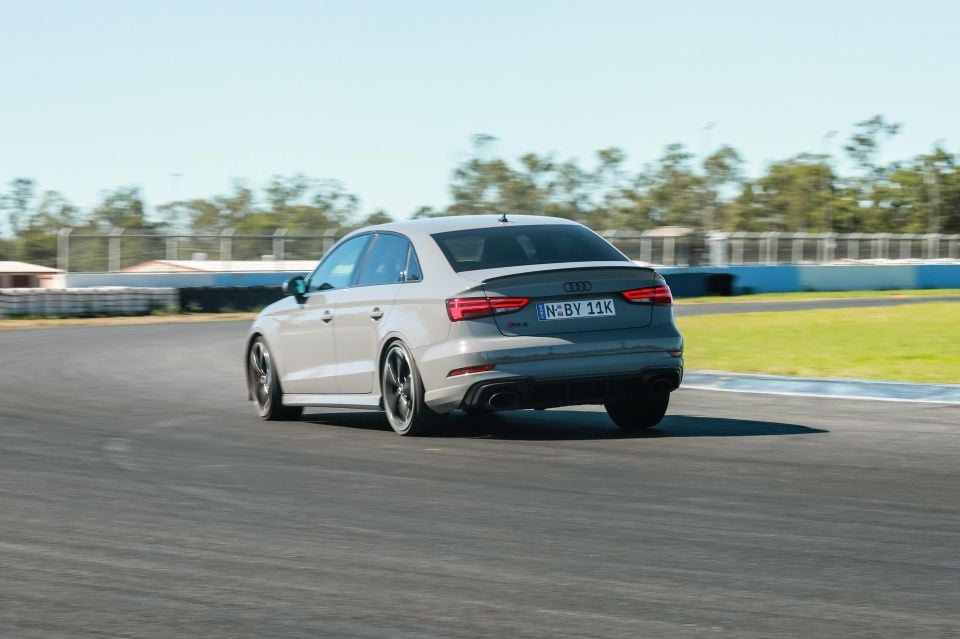

Performance Editor

Performance Editor


Performance Editor

Performance Editor
Where expert car reviews meet expert car buying – CarExpert gives you trusted advice, personalised service and real savings on your next new car.
It’s fantastic to start to see some depth on our leaderboard and get a clear understanding of how performance numbers equate to real-world performance – and whether the cost associated with the result and experience are justifiable.
Now with the Audi RS3 we have a mid-pack contender, which gives us an insight into the advantages over its stablemate, the S3, and how much of a performance gain we get for the extra cost.
It’s also the showdown I have been waiting for with the current class-leading Mercedes-AMG A45 S.
We have already seen the SUV variant, the Audi RSQ3 Sportback, do a respectable sub-60-second lap with an almost 200kg weight disadvantage.
Therefore, we also get to see the difference weight and centre of gravity make between the RS3 and its RSQ3 stablemate.

I have always found Audis do a great job of balancing performance with drivability and flexibility across a variety of driving experiences.
The Audi RS3 was no different and took to the track with ease, but without being absolutely on a knife’s edge.
This car will be something a lot of people appreciate, as it inspires confidence and it’s easy to drive quickly without threatening to throw you off at any second.
The Audi RS3 is also a car that could very easily be dialled up to another level if track days are a priority.

As I have already alluded to, the Audi RS3 effortlessly performs on public roads.
Some of the slight negatives that are highlighted on the track fade into insignificance on the road.
The Audi RS3 inspires confidence on the shorter-radius corners and is nimble without being overtly harsh.
It offers great balance between a user-friendly daily driving experience and an all-out corner-carving weapon.

The 2.5-litre turbocharged inline five-cylinder petrol engine with 294kW of power and 480Nm of torque sounds amazing, but just lacks the flexibility to be absolutely perfect on the track.
The impressive part once again with Audis is the launch control system. I managed a 4.23-second 0-100 time in only a couple of attempts, which is a fraction off Audi’s official claim of 4.1 seconds.
Peak power is excellent, but it’s very important to be in a right gear at all times, as the engine lacks response lower in the rev range.
On the road Audi has managed the balance between comfort and dynamic mode perfectly. It is so easy to cruise around smoothly in traffic and then it comes alive with the flick of a switch when the road opens up.
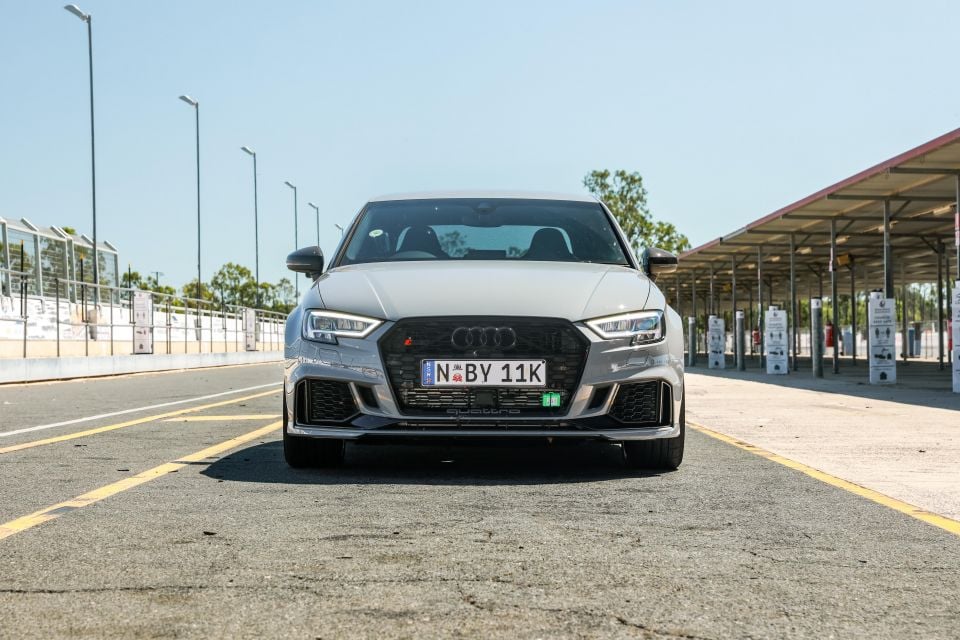
Interestingly, I didn’t have as big an issue with the brakes as I did with the Audi RSQ3. The brake pedal was actually really consistent and very strong when the car was deep in the braking zone.
I still would have liked the ability to modulate the brakes better. It was a real challenge to release the brake pedal smoothly into the corner, which is key to doing a good lap.
It is not something most people are going to pick up on, but in order to extract everything from the car, this is very important.
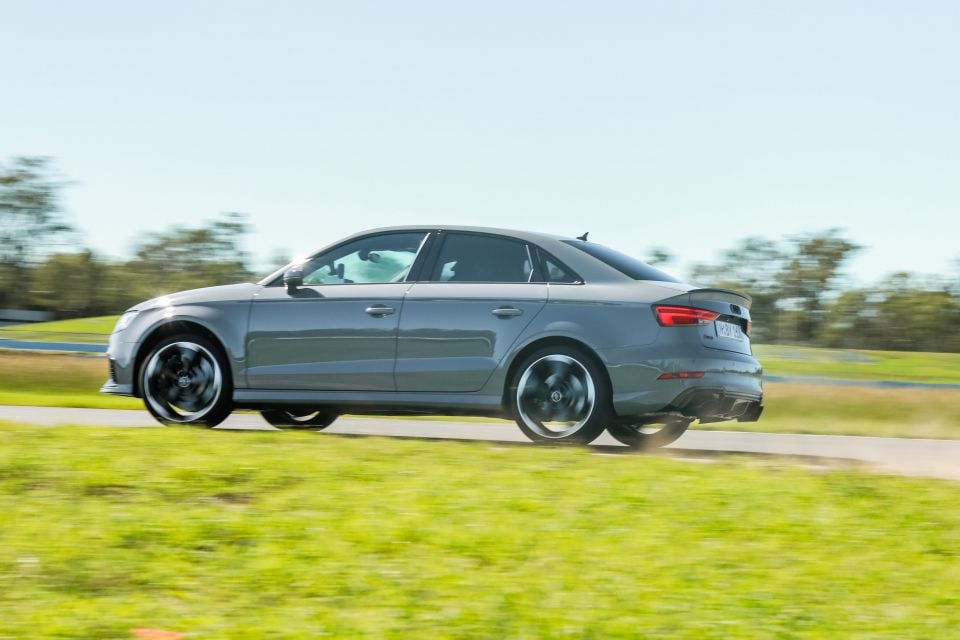
Fundamentally the chassis is very solid and very close to being spot-on, but like the Audi RSQ3 it’s just missing something to help it perform ideally on track.
The amount of movement in the chassis, even in the dynamic suspension mode, felt really good but the initial reaction from the front as it went into compression seemed to lack a little grip and it just wanted to slide rather than react. This was both in a straight line and on corner entry.
Yet as you continued to build up load, the chassis was very stable offering a good platform to lean on.
This was very clear on the braking test and the Audi RS3 felt incredible in the last phase of braking from 100-0, with a very level platform and the ability to adjust the line while under full load.
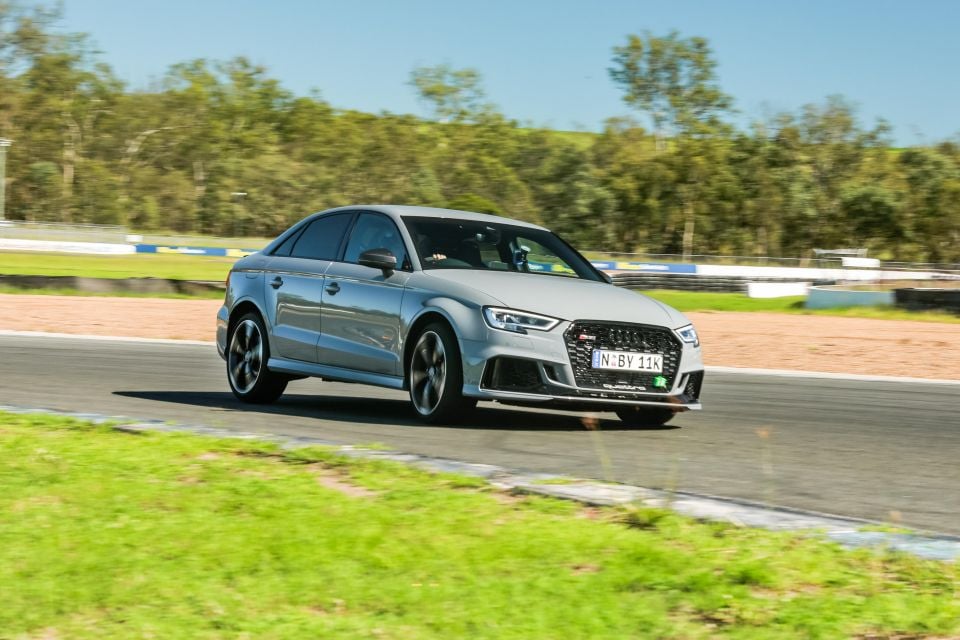
If you mange everything well you can get the car to rotate, but it was a little too close to the limit in this regard.
Audi hasn’t pushed the setup of the RS3 as far as some other manufacturers, and it wouldn’t be hard with some slight camber changes to improve this. But it’s on the company’s mind as you can see by the staggered tyres front-to-rear in a bid to manage understeer.
Interestingly, with this being the sedan, I found it a bit more stable (understeer-biased) than the S3 Sportback we tested. It sits on the same 2628mm wheelbase but with a 154mm longer body, which would be beyond the rear wheels. This will have quite a large effect on the ability to rotate the car as well.
The great thing about all of this is it’s actually an easy car to drive fast – it’s not nervous or scary and you won’t get any big surprises.

The seven-speed ‘S tronic’ dual-clutch automatic transmission is good but not my favourite on the track. You have to be very patient with the downshifts and really allow the car to wash off speed before flicking the paddle. Upshifts were fast, smooth and had no issues at all.
On the road there is less of a concern with downshifts, as it’s very rare you will be trying to decelerate at the same rate and intensity as you would at a circuit.
The quattro AWD system here is a Haldex system, with the balance having a bias towards front-wheel drive and I really feel a more equally driven system with stronger locking would make this car an epic experience.
To carry speed with the Audi RS3, it requires a small amount of push and unfortunately you can’t use the throttle to adjust that balance.
Traction is not an issue at all, though, and that’s shown in the 0-100 performance.
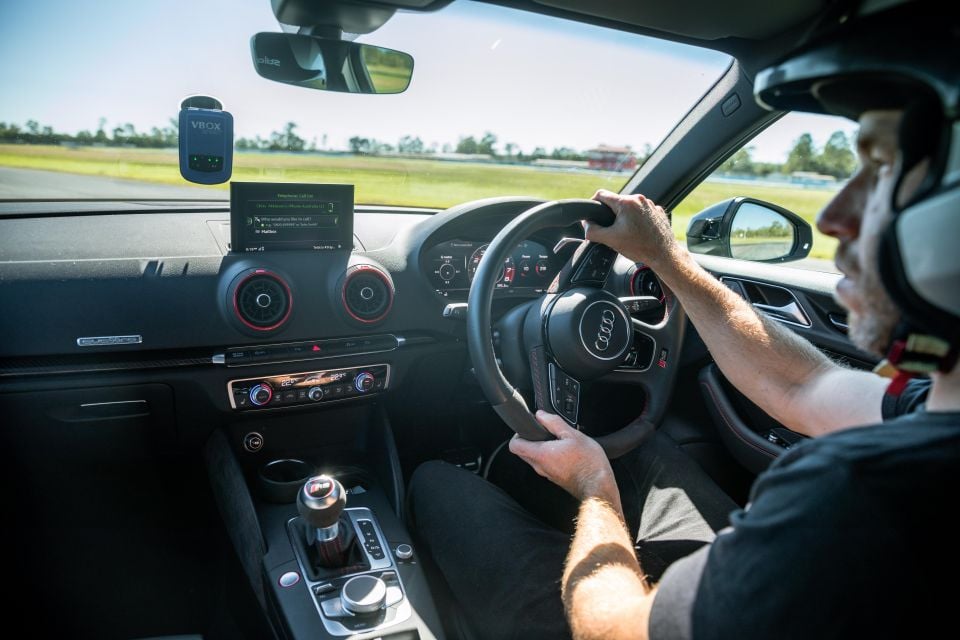
The sports suspension with adaptive dampers in the Audi RS3 feels very well sorted, there’s a nice amount of movement and use of travel and it isn’t harsh on track or on the road.
The front and rear are in balance and the platform it creates when loaded is excellent. There isn’t too much lifting, which will inspire confidence for a lot of drivers.
The steering again ticks all the boxes, and I can’t pick anything major to fault, other than that I would like a bit more of a connected feeling to the road.
This is really nit-picking honestly, and is not a make-or-break aspect of the RS3.

In an interesting move Audi has opted to stagger the tyres front and rear, with Pirelli P Zero 255/30 R19 on the front and 235/35 R19s on the rear.
This effort to improve front grip will help a bit, but the wear marks on the side wall of the front-left tyre indicate there is also a camber issue when loaded.
The tyres did drop off significantly in performance when they got hot, which in turn increased understeer.
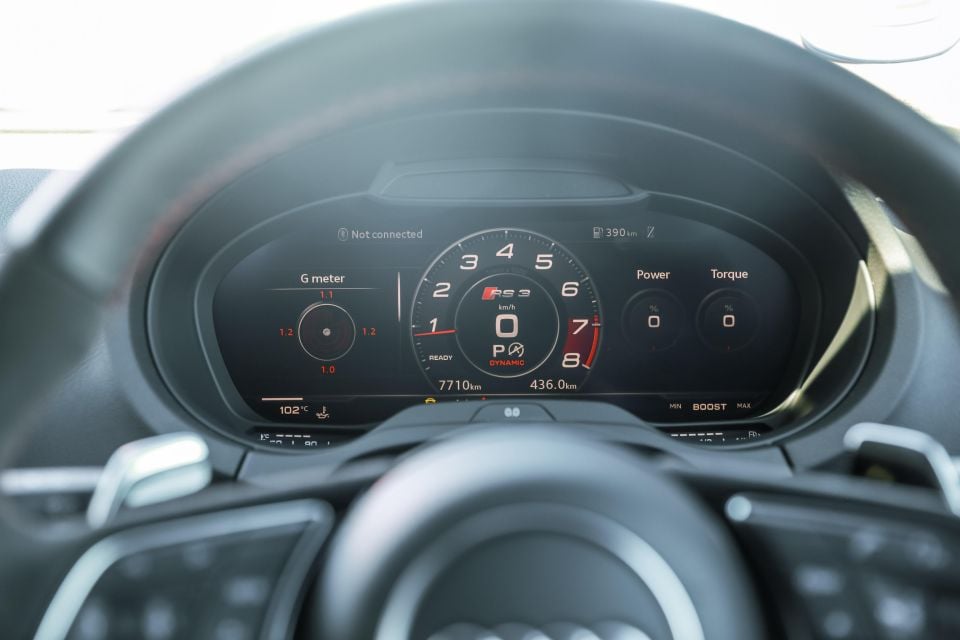
I made a small mistake and did the first lap with the traction control and ESC on, and I was actually amazed by the difference it made. My next lap I turned both off completely and went 1.5 seconds faster.
Because Audis respond well to being driven a bit more aggressively, the safety systems can really restrict the ability to get the most out of the car. Personally I never felt uneasy with everything switched off and it would have taken a big mistake to come unstuck.
Ideally, I would have liked a bit more room to move before being controlled in a performance car like this.
I also ran with everything in Dynamic mode for all laps, with the only thing worth trying depending on the situation would be the slightly softer suspension setting.
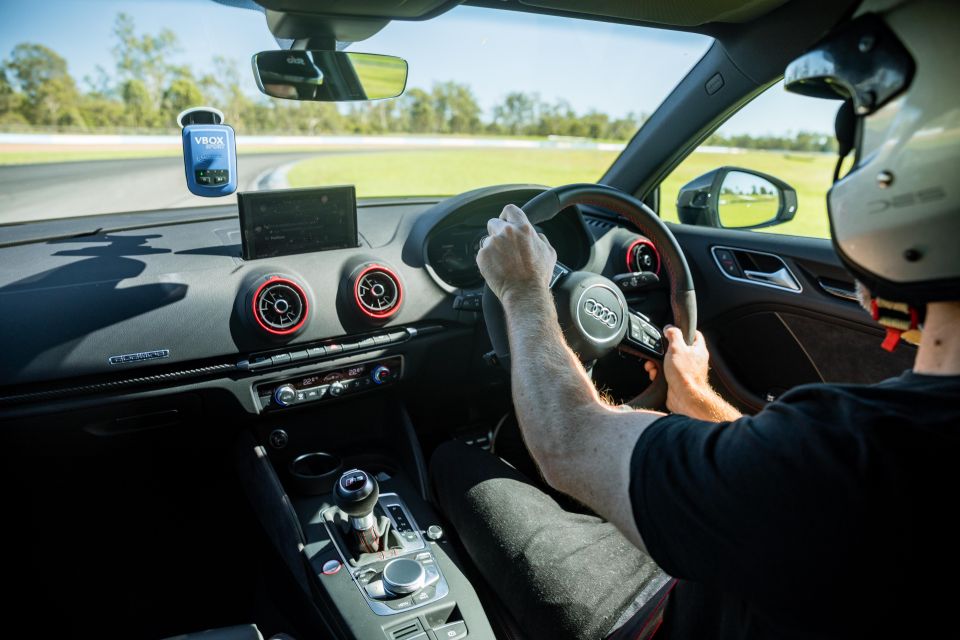
As with the Audi RSQ3, I really liked the steering wheel – the size, shape and texture with the Alcantara finish – which is great for track use and perfect on the road as well.
I liked the seats and the positioning. They offer excellent everyday comfort, plus enough lateral support when on full ‘attack’ mode.
The digital dash and the way the shift lights are integrated into the tacho display are also really cool while easy to read and react to.
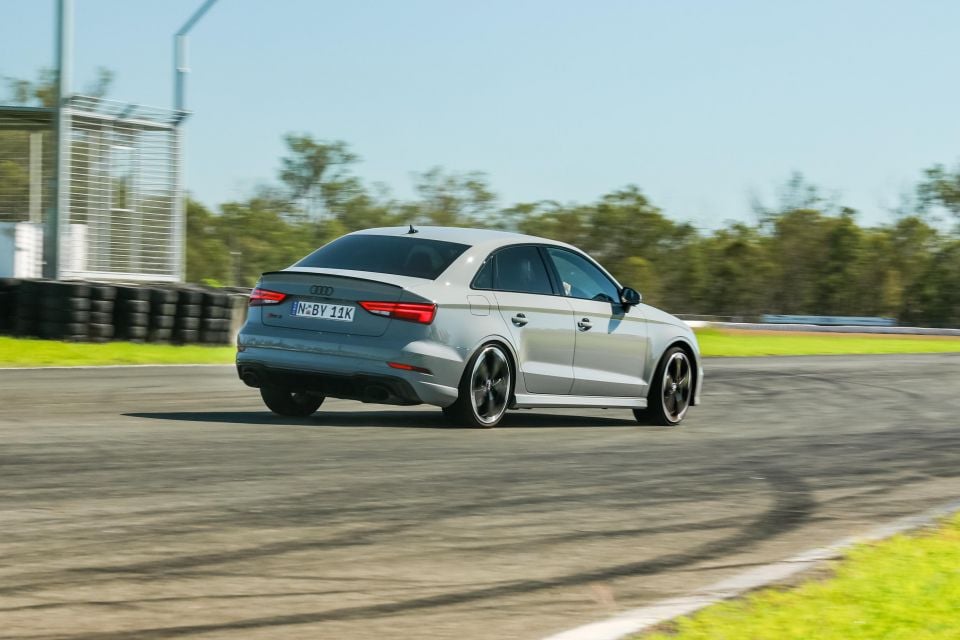
For me this was all about the Audi RS3 v Mercedes-AMG A45 S battle. Could it match the 58.15-second time of the AMG – unfortunately, no it didn’t.
The best lap was 58.91 seconds, which slots it right behind the Mercedes on the leaderboard. The fact we achieved the times on different days with different tyres, indicates they are very close and both are super quick.
The great thing about the Audi RS3 is its balanced nature and the ability to live with it every day, then unleash its potential with ease on track.

Where expert car reviews meet expert car buying – CarExpert gives you trusted advice, personalised service and real savings on your next new car.
Click the images for the full gallery
Where expert car reviews meet expert car buying – CarExpert gives you trusted advice, personalised service and real savings on your next new car.


CarExpert.com.au
4 Hours Ago


Damion Smy
17 Hours Ago


Damion Smy
20 Hours Ago


Damion Smy
1 Day Ago


Damion Smy
1 Day Ago


Damion Smy
1 Day Ago